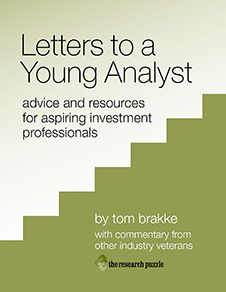
- Wednesday, November 10th, 2010
- two kinds of safety
-
It was almost seven years ago that Malcolm Gladwell wrote a classic New Yorker article on automobile safety and the SUV craze.Gladwell.com | It was titled, “Big and Bad,” but don’t let that turn you off if you drive one. It remains a great read, with science, behavior, and psychology all thrown in together — and some clear analogies available to the market observer.
I happened to think of it in light of feedback I received on my posting about how “size matters”the research puzzle | Be sure to check out the quotes from some well-known portfolio managers. for asset management firms and those who select them to manage their money. The key insight of Gladwell’s piece remains true today: Consumers continue to think about safety in one dimension. That is, if you’re in a bigger vehicle, you are safer. That’s not really the case.
Regarding vehicle safety, there are two elements at work, which can be broadly described as protection and maneuverability. Buyers of SUVs tend to think entirely in terms of the former (although another aspect of Gladwell’s piece is that the frame of an SUV can be less protective than that found on some smaller cars). In reality, maneuverability is highly important when it comes to the safety of the driver, the occupants, and those in other vehicles or otherwise in the way. And SUVs as a group have been woeful in that regard.
Gladwell included statistics for various models (it would be interesting to see what representative ones look like today) and reported on his hands-on tests of a TrailBlazer versus a convertible Porsche Boxster. We feel that “in the TrailBlazer our chances of surviving a collision with a hypothetical tractor-trailer in the other lane are greater than they are in the Porsche. What we forget, though, is that in the TrailBlazer you’re also much more likely to hit the tractor-trailer because you can’t get out of the way in time.”
That brings us back to the issue of size in investing. In doing equity analysis, for example, you have to judge whether a firm is headed in the wrong direction and too big, bureaucratic, and sclerotic to make a correction in time. (Knowing that some firms may be lucky enough to be protected by a too-big-to-fail air bag.) We’ve witnessed accident after accident involving companies that had seemed invincible on the highways of capitalism.
While size can definitely have its advantages, we often get lulled into ignoring the accompanying risks. That’s true for asset management firms, as explored in the previous posting, and with investment strategies whose popularity takes them to a size where maneuverability comes into question.Bloomberg | Say, for example, quant funds in advance of August 2007. Everything seems to be going along fine until one of the risks of the road comes into play.
The selling of safety in financial products is a lot like the selling of safety in vehicles, even if it doesn’t involve fitting as many cup holders as possible into the offering. (Yes, cup holders translate into “safety” in the minds of consumers.) The purveyors of an investment can’t sit you high up in it to take advantage of a “point of view” trick like the sellers of an SUV can, but they’ll provide charts and graphs and history to give you the same sense of mastery over your destiny, even if it doesn’t really exist.
Importantly, no matter the inherent risks, our behaviors — be it as owners of “paper” or drivers of motoring machines — are critical. The driver of an SUV that has the mistaken notion of invincibility is to be feared, but so is the person commanding a Porsche who thinks he can drive his way out of any situation. The risk/return relationship can change dramatically by virtue of our attitudes and actions. That’s as true with investment decisions as with those behind the wheel.
No matter your preferences in investments or vehicles, Gladwell’s wonderful article will make you think twice about your expectations before venturing forth.
